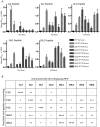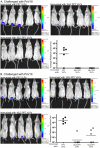A pan-HPV vaccine based on bacteriophage PP7 VLPs displaying broadly cross-neutralizing epitopes from the HPV minor capsid protein, L2
- PMID: 21858066
- PMCID: PMC3157372
- DOI: 10.1371/journal.pone.0023310
A pan-HPV vaccine based on bacteriophage PP7 VLPs displaying broadly cross-neutralizing epitopes from the HPV minor capsid protein, L2
Abstract
Background: Current human papillomavirus (HPV) vaccines that are based on virus-like particles (VLPs) of the major capsid protein L1 largely elicit HPV type-specific antibody responses. In contrast, immunization with the HPV minor capsid protein L2 elicits antibodies that are broadly cross-neutralizing, suggesting that a vaccine targeting L2 could provide more comprehensive protection against infection by diverse HPV types. However, L2-based immunogens typically elicit much lower neutralizing antibody titers than L1 VLPs. We previously showed that a conserved broadly neutralizing epitope near the N-terminus of L2 is highly immunogenic when displayed on the surface of VLPs derived from the bacteriophage PP7. Here, we report the development of a panel of PP7 VLP-based vaccines targeting L2 that protect mice from infection with carcinogenic and non-carcinogenic HPV types that infect the genital tract and skin.
Methodology/principal findings: L2 peptides from eight different HPV types were displayed on the surface of PP7 bacteriophage VLPs. These recombinant L2 VLPs, both individually and in combination, elicited high-titer anti-L2 IgG serum antibodies. Immunized mice were protected from high dose infection with HPV pseudovirus (PsV) encapsidating a luciferase reporter. Mice immunized with 16L2 PP7 VLPs or 18L2 PP7 VLPs were nearly completely protected from both PsV16 and PsV18 challenge. Mice immunized with the mixture of eight L2 VLPs were strongly protected from genital challenge with PsVs representing eight diverse HPV types and cutaneous challenge with HPV5 PsV.
Conclusion/significance: VLP-display of a cross-neutralizing HPV L2 epitope is an effective approach for inducing high-titer protective neutralizing antibodies and is capable of offering protection from a spectrum of HPVs associated with cervical cancer as well as genital and cutaneous warts.
Conflict of interest statement
Figures









Similar articles
-
VLPs displaying a single L2 epitope induce broadly cross-neutralizing antibodies against human papillomavirus.PLoS One. 2012;7(11):e49751. doi: 10.1371/journal.pone.0049751. Epub 2012 Nov 19. PLoS One. 2012. PMID: 23185426 Free PMC article.
-
Broad Cross-Protection Is Induced in Preclinical Models by a Human Papillomavirus Vaccine Composed of L1/L2 Chimeric Virus-Like Particles.J Virol. 2016 Jun 24;90(14):6314-25. doi: 10.1128/JVI.00449-16. Print 2016 Jul 15. J Virol. 2016. PMID: 27147749 Free PMC article.
-
A novel candidate HPV vaccine: MS2 phage VLP displaying a tandem HPV L2 peptide offers similar protection in mice to Gardasil-9.Antiviral Res. 2017 Nov;147:116-123. doi: 10.1016/j.antiviral.2017.09.012. Epub 2017 Sep 20. Antiviral Res. 2017. PMID: 28939477 Free PMC article.
-
Developments in L2-based human papillomavirus (HPV) vaccines.Virus Res. 2017 Mar 2;231:166-175. doi: 10.1016/j.virusres.2016.11.020. Epub 2016 Nov 23. Virus Res. 2017. PMID: 27889616 Free PMC article. Review.
-
Virus-like Particle-Based L2 Vaccines against HPVs: Where Are We Today?Viruses. 2019 Dec 23;12(1):18. doi: 10.3390/v12010018. Viruses. 2019. PMID: 31877975 Free PMC article. Review.
Cited by
-
Multivalent human papillomavirus l1 DNA vaccination utilizing electroporation.PLoS One. 2013;8(3):e60507. doi: 10.1371/journal.pone.0060507. Epub 2013 Mar 25. PLoS One. 2013. PMID: 23536912 Free PMC article.
-
The Breadth of Bacteriophages Contributing to the Development of the Phage-Based Vaccines for COVID-19: An Ideal Platform to Design the Multiplex Vaccine.Int J Mol Sci. 2023 Jan 12;24(2):1536. doi: 10.3390/ijms24021536. Int J Mol Sci. 2023. PMID: 36675046 Free PMC article. Review.
-
A cholesterol-lowering VLP vaccine that targets PCSK9.Vaccine. 2015 Oct 26;33(43):5747-5755. doi: 10.1016/j.vaccine.2015.09.044. Epub 2015 Sep 26. Vaccine. 2015. PMID: 26413878 Free PMC article.
-
RG1-VLP and Other L2-Based, Broad-Spectrum HPV Vaccine Candidates.J Clin Med. 2021 Mar 3;10(5):1044. doi: 10.3390/jcm10051044. J Clin Med. 2021. PMID: 33802456 Free PMC article. Review.
-
Bacteriophage Virus-Like Particles: Platforms for Vaccine Design.Methods Mol Biol. 2024;2738:411-423. doi: 10.1007/978-1-0716-3549-0_24. Methods Mol Biol. 2024. PMID: 37966612 Review.
References
-
- Chen XS, Garcea RL, Goldberg I, Casini G, Harrison SC. Structure of Small Virus-like Particles Assembled from the L1 Protein of Human Papillomavirus 16. Molecular Cell. 2000;5:557–567. - PubMed
-
- de Villiers EM, Fauquet C, Broker TR, Bernard HU, zur Hausen H. Classification of papillomaviruses. Virology. 2004;324:17–27. - PubMed
Publication types
MeSH terms
Substances
Grants and funding
LinkOut - more resources
Full Text Sources
Other Literature Sources

